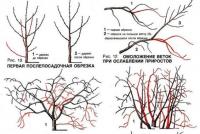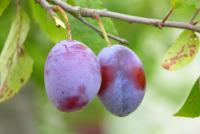Lilac cuttings in summer. Propagation of varietal lilac
In late spring and summer, lilac can be easily propagated at home with the help of rooted green cuttings. In the article we will describe in detail and show how to do it correctly.
Lilac ornamental varieties propagated by shoots, layering, grafting and cuttings. To instill lilac, you need to have some skills, and it is convenient to multiply a bush already growing in a country house with shoots and shoots. If you want to bring the plant from another place, it is best to resort to grafting. With this method you can rotate the lilac even from a bouquet. Provided that it was cut no later than one day ago.
Also, keep in mind that lilac is a hard-to-root plant. Therefore, for successful breeding it is important to observe certain conditions:
- Do not miss a suitable period for harvesting cuttings. Green twigs of lilac cut during flowering or immediately after it, as woody cuttings do not root. And it's best to do it early in the morning.
- Use suitable cuttings. They need to be cut from the middle of the crown of young bushes (up to 6 years old) and from the middle part of the shoot. At the same time on the handle (10-15 cm long) must be 2-3 buds. Shoots coming from thick boughs (tops) are unsuitable.
- Withstand temperature and humidity. The optimum temperature for rooting cuttings - 22-25 ° C, and humidity - 85-95%.
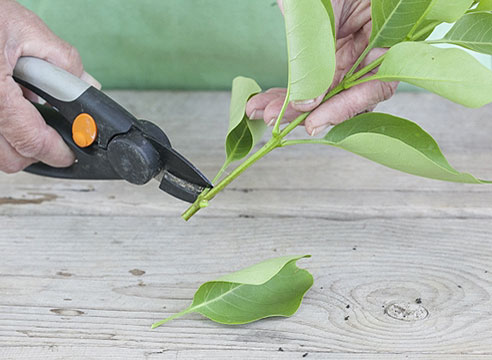
Preparation of green cuttings
1. Using a sharp pruner, remove the leaves from the lower node of the cutting.
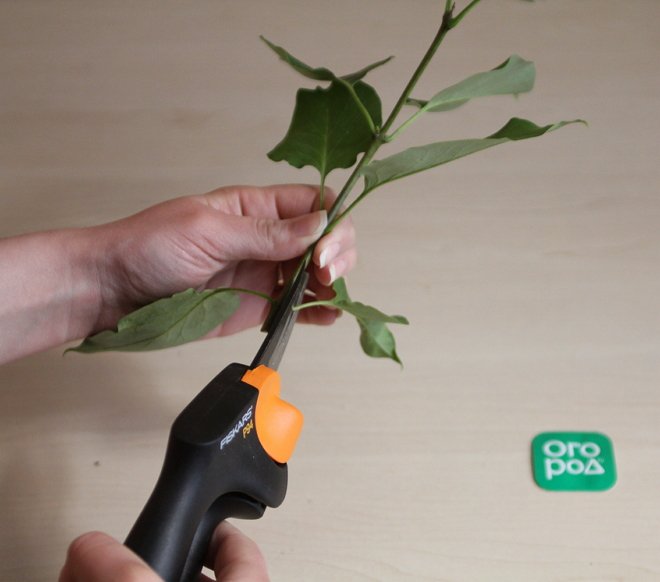
2. As close as possible to this node, without leaving a stump, make an oblique cut. Note: cuttings with cuts in the internodes are not rooted.

Treat the cutting on the handle very carefully: the lilac roots grow only in the lower node. And a wrongly made cut will cause the plants not to take root.
3. Cut all leaves remaining on the handle by half.
![]()
4. Above the top knot, departing 1 cm, cut off the top of the shoot. In this case, the cut should be smooth.

5. Put the prepared cuttings into the solution with the root stimulator.
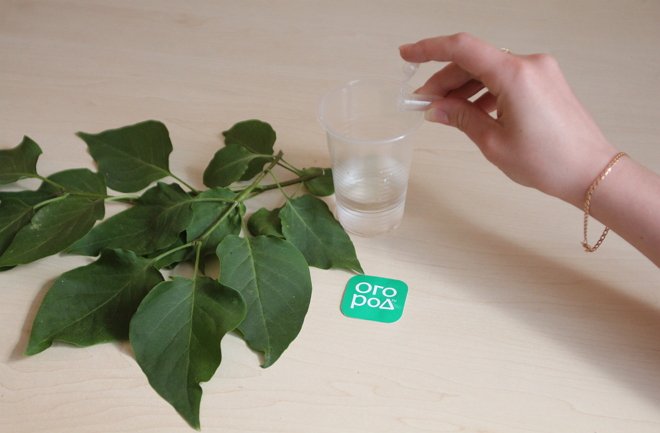
Water temperature should be between 18-20 ° C. To do this, you can use any drug, but, as shown by our experiment, it is more efficient to use Epin-Extra. Keep cuttings in the stimulator solution for 14-17 hours.
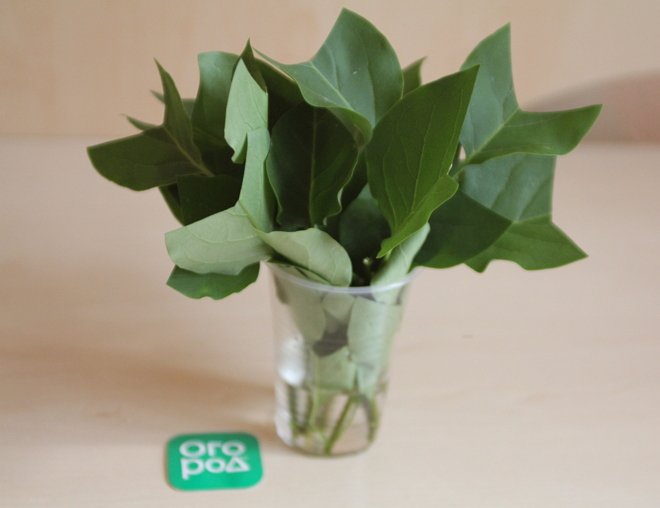
1. Prepare the soil. It is better to root the cuttings in a mixture of peat (2 parts) and coarse-grained perlite (1 part). Sand add undesirable.
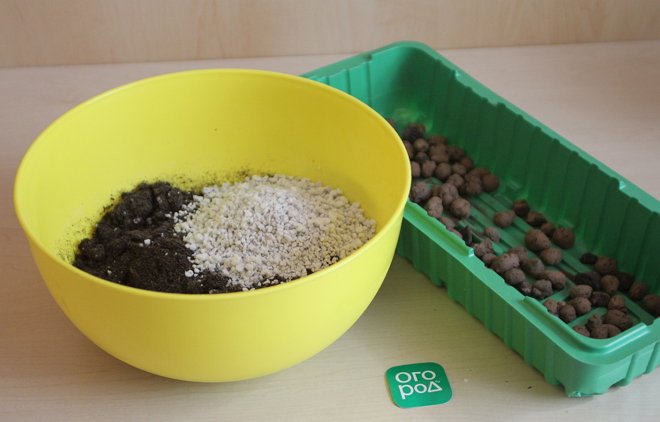
2. In the handle (or any other container with a plastic lid) pour a small layer of drainage, and on top of it - prepared soil mixture in a layer of 10 cm.
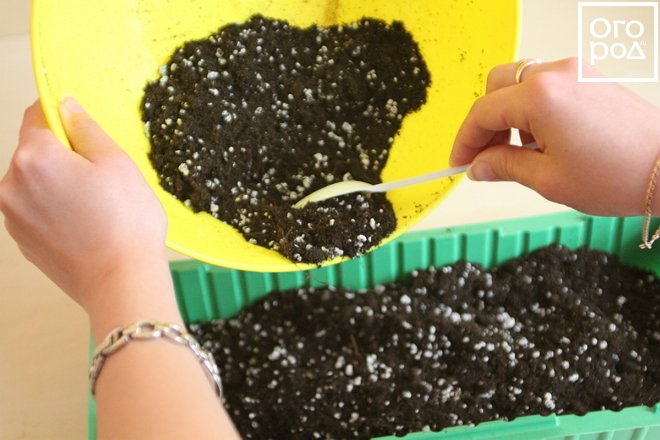
Then pour a layer (3 cm) of coarse sand - it is desirable to use river.

3. Liberally moisten the soil. To avoid infection with fungal diseases, you can shed the earth with a solution of fungicide (Fundazol).

4. In a wet sand, use a thin stick to make a small hole and place a cutting in it to a depth of 1 cm. Make sure that the cutting of the cutting is in the sand, but does not touch the soil mixture. The remaining cuttings are planted so that they do not cling to each other leaves.
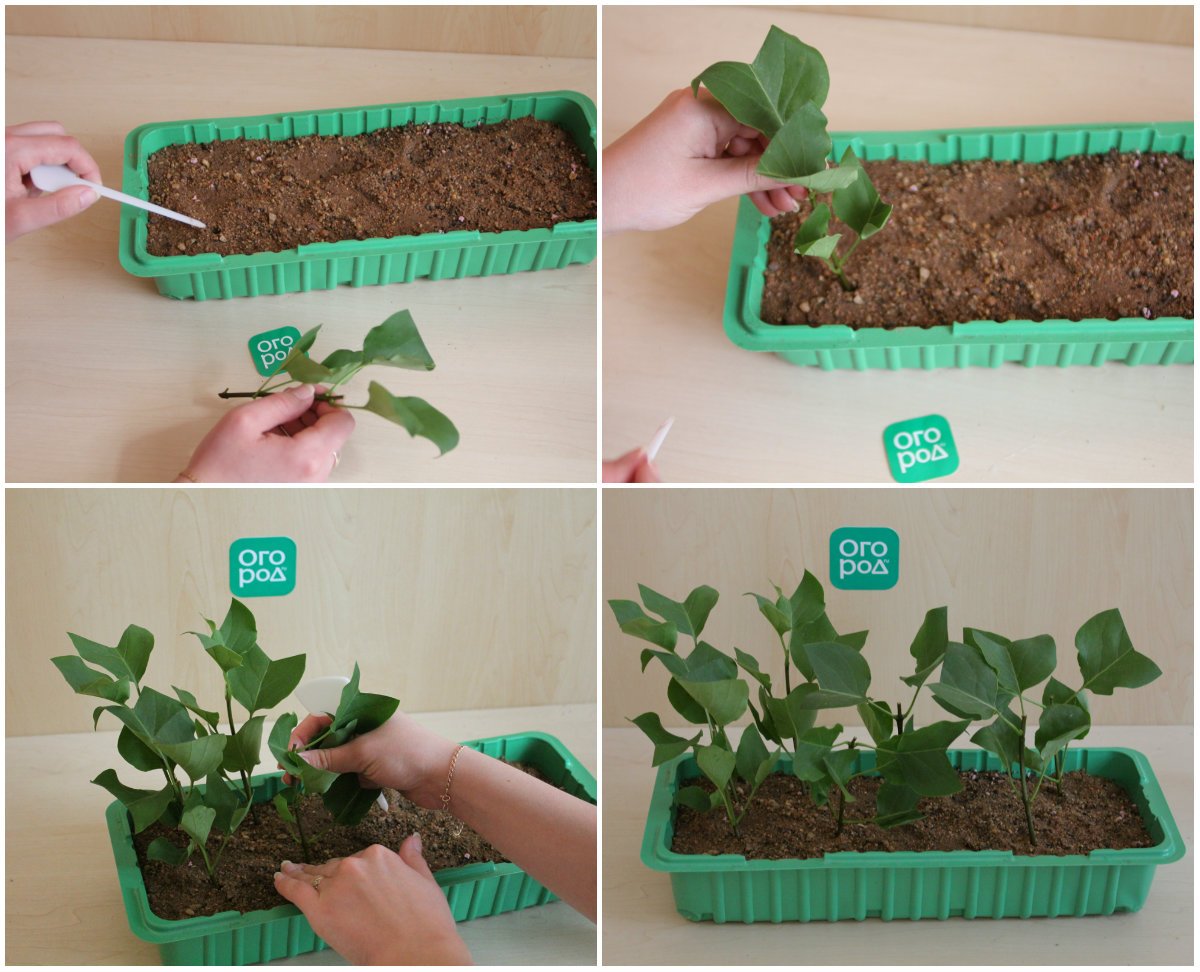
5. Spray cuttings from the spray with water at room temperature.
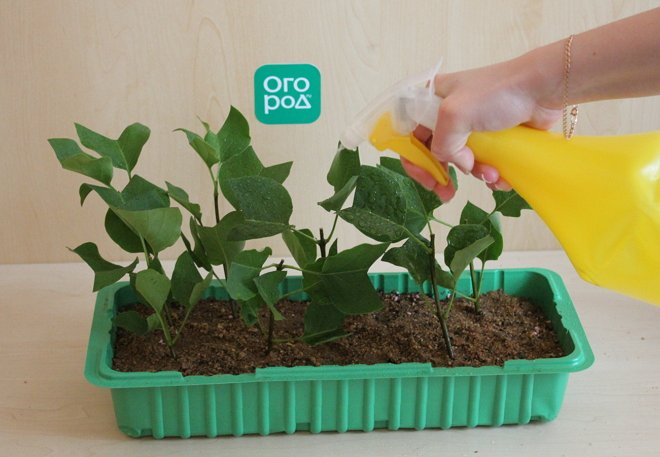
6. Cover the container with a transparent plastic cap (you can use a cut-off plastic bottle) or a film and place it in penumbra.
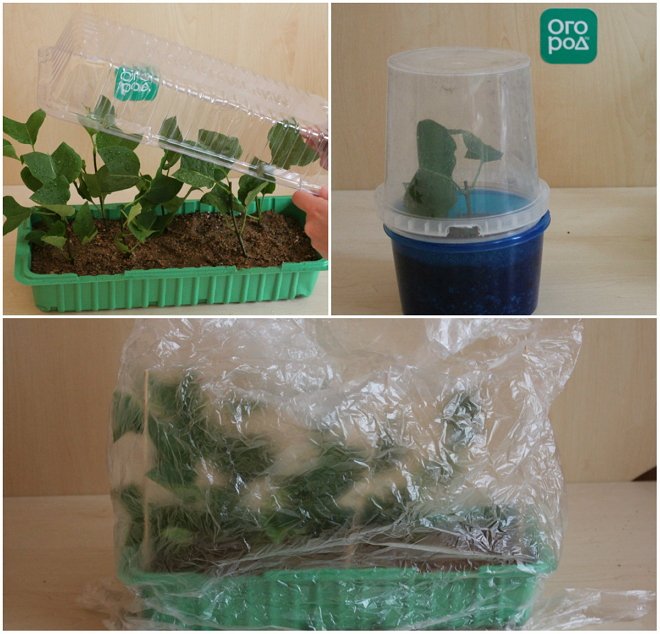
Lilac cuttings care
To maintain humidity, spray cuttings daily with water. The sand should not dry out. To prevent mold from forming on the leaves, once a week, spray them with a light pink solution of potassium permanganate.
As necessary, blot the resulting condensate, and after the formation of the roots of the cuttings begin to air.
Usually the roots appear in 30-60 days. Until the autumn, grow the cuttings in the cuttings (if they managed to take root by this time), and in September you will land on a growing bed located in a well-lit place with a light, fertile soil of neutral acidity, then pour it. The distance between the cuttings should be about 30 cm.
If in the fall the leaves on the cuttings darkened - do not worry. It is important that the kidneys and roots are not extinct.
For the winter, cover the cuttings with spanbond or spruce branches. In the spring with the onset of warm weather, remove the shelter. After 1-2 years, the lilac sapling can be transplanted to permanent place. And after 2-3 years the plant will bloom.
As you can see, to grow a lilac from green cuttings is easy. But at home, they tend to take root only in 50-70% of cases. Therefore, harvest a few branches of lilac.
The varietal lilac is very much appreciated by gardeners, landscape designers and collectors. By purchasing a sapling, the buyer hopes for full compliance of the copy with varietal characteristics.
Breeding
Not all methods equally transmit the genetic code. Therefore, for the reproduction of varietal bushes apply a limited number of them.
You can multiply:
- inoculation;
- root shoots;
- layering;
- green (not lignified) cuttings;
- merisystem way.
You can not reproduce:
- seeds.
Comparison of breeding methods of varietal lilac
For each, you can highlight the positive aspects and negative.
The own-rooted lilac is healthier - it has a high winter hardiness, a large increase, the shoots inherit the signs. A significant drawback is that it is time for flowering to occur three or even four years later than that of the vaccinated.
The grafted syring blooms earlier. From it you can form a stage tree. Reception common in modern landscape design. Alas, she lives significantly less than her own. It is considered more sustainable vaccination on the wild. With proper care, the bush can become a shrub with other rootstocks.
Lilac grown merisystem, also own-rooted. It better conveys the characteristics of the variety, less sick with viral and other diseases, it is easier to tolerate difficult climatic conditions. The sapling obtained by the merisystem method gives a small increase in the first years. Blossoms no earlier than the fifth year.
Technique
The easiest way to plant root growth. A little harder and longer to make layering. The most popular method is green cutting, which is not suitable for all varieties. The process of grafting is difficult for the grower and requires good skill and experience. Must be available and a special tool. It is impossible to multiply lilac merisystem outside of laboratory conditions.
Now more, how to propagate the lilac.
Grafting
Inoculation multiply any varieties. The rootstock for grafting are wild seedlings, privet, Hungarian lilac.
In grafted plants, shoots in the circle around the root collar and near the root collar are not varietal, wild, so it is completely removed with shears “on the ring”.
For graft take annual twigs syringes. Harvest them in advance and store them before grafting in a wet, cold and dark place.
There are such ways:
- budding;
- copulation;
- side grafting;
- graft splitting;
- behind the bark.
Root growth
The separation of the root shoots is best done in the fall. The desired copy is cut off from the main root with maximum preservation of its own fibrous root system. AT further landing and the care of the separated plant is carried out as normal seedlings.
Layering
For propagation of varieties by layering, root-bearing brood bushes are mainly used. The process takes several years.
1-2 year. To prepare for winter in the first and second year, the shrub intended for breeding with the help of cuttings is cut to the very root of the neck.
3 year. By the fall on the bush will be a lot of young shoots.
4 year. In the spring, the grown-up annual shoots bend down to the ground, fastened with hooks hammered into the ground and sprinkled with soil. The whole season should be monitored so that the soil near the cuttings is sufficiently moist. In the fall of the fourth year, rooted cuttings are separated from the branches of the uterine bush.
Less often, grafted lilacs are transferred to their own roots by layering, if the graft is not very high above the ground. The plant is planted obliquely. In the spring to the ground attract shoots that are above the vaccine. Use a special wire and pins. Plant spud during the growing season and watered. In the autumn, above the waist, roots will appear, and the layouts can be cut off from the bush.
With this method, you can get the largest number of seedlings from a single shrub in a short time.
Reproduction of lilac cuttings in the spring
This method can multiply some varieties in one season. The process includes the following steps:
- the choice of material and its preparation for vegetative reproduction;
- cut the green cuttings;
- preplant treatment shoots;
- soil preparation;
- planting the prepared material;
- rooting;
- transplant ingrained in open ground for growing.
Let us dwell more specifically on the main points.
How to choose shoots for grafting and prepare for cutting
The older the queen bush, the worse the rooting takes place. The plant must be at least 4-5 years old, but not older than 10-15.
Large green shoots, they are also called fatty, practically do not take root. Vertical strong - also not very suitable. Better ability to form roots in small green branches growing sideways.
To increase the rooting rate of cuttings, gardeners use various tricks. In particular, use "etiolation". Dark-colored insulating tape 3 weeks before grafting is wrapped around not very tight young shoots from below under the internode. In essence, etiolation is the isolation of a part of a branch from light. After some time, the areas of bark under the isolation will become whitish, it is here that you need to make a cut, and approximately 10 weeks later the roots will develop in this place.
Time pruning - evening, you can morning, if the day promises to be overcast. Then the sprig will spend less moisture on its most difficult first day.
Green cutting rules
 Grafting is carried out during the flowering period or immediately after it. Selected shoots are cut with a clean, sharp knife. At the shoot, the tip is cut off, two or three internodes are counted, and the lower part is cut off. Important!The lower cut should be oblique and pass immediately under the third node, but not touching it.
Grafting is carried out during the flowering period or immediately after it. Selected shoots are cut with a clean, sharp knife. At the shoot, the tip is cut off, two or three internodes are counted, and the lower part is cut off. Important!The lower cut should be oblique and pass immediately under the third node, but not touching it.
On the shoots, all the leaves are cut to half and packaged in a film in thin layers until planting. It is not necessary to put in the water.
Pre-treatment
The branches rooted very hard. Therefore, before planting, they are necessarily treated with root formation stimulants (indolylbutyric acid, heteroauxin, zircon). Preparations are diluted with water or alcohol according to the instructions. If alcohol dilution was used, shoots are dipped into the solution for 5 seconds and planted into the ground; if water dilution, they are kept for 18 hours, dipped to a depth of 1 cm.
Soil preparation
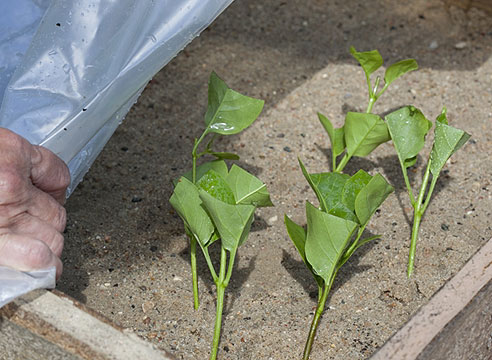 Most often rooted in the sand or a mixture of sand and perlite. But in order to achieve the highest percentage of rooting, it is better to use such a composition: part of large perlite, part of high-moor peat, two parts of low-moor peat.
Most often rooted in the sand or a mixture of sand and perlite. But in order to achieve the highest percentage of rooting, it is better to use such a composition: part of large perlite, part of high-moor peat, two parts of low-moor peat.
The drainage layer of washed sand and expanded clay - 15 cm, then 20 foliar humus or rotted manure, and on top of five to eight centimeters of the mixture for rooting.
Landing
The prepared soil is compacted and watered. Cuttings deepen, immersing the first internode in the ground completely. It is under it that the system of fibrous roots will develop. Between rows we leave a distance of 10 cm, and between shoots - 5 cm. We water once more.
The temperature should not be very high. If it's hot outside, the greenhouse is littered and ventilated.
The most important condition for a good survival rate is high humidity, ideally 100%. For rooting commercially in greenhouses, a special fogging machine is installed.
The first roots can appear no earlier than in a month and a half.
Do not forget to periodically remove fallen or damaged leaves to prevent fungal infections.
Talk about the percentage of rooting can only be in the fall. At the same time they can be seated for growing on the school bed. Do not forget to cover the saplings for the winter in order to prevent freezing of tender still shoots. If in doubt, it is better to transplant the rooted cuttings next spring, as usual, before the start of sap flow.
Merisystem method
Modern science makes it possible to obtain plants by growing tissues in a laboratory - this is the “merisystem” method of reproduction.
The technique consists in growing cell varietal shoots on a nutrient medium. The plants obtained by this vegetative method acquire all parental signs.
No related articles.
Breeders regularly display new varieties of lilac. Lush tassels of fragrant flowers will decorate any garden, and naturally the gardener's desire to propagate the variety he likes. Lilac bushes propagated by grafting, as well as layering and cuttings. Accordingly, grafted (developed after inoculation on the roots of the rootstock) plants and root-bearing ones (obtained from cuttings and cuttings and forming their own root system).
Root-own lilac has significant advantages over the graft: its life cycle is significantly longer (up to 25, and in favorable conditions - up to 50 years); care for it is not complicated by the need to regularly remove the root growth; with further reproduction, own-rooted plants give high-quality varietal planting material. Therefore, despite the complexity, this method of propagation of lilac as cutting, deserves the attention of gardeners.
The choice of uterine plants and harvesting cuttings of lilac
Cuttings should be harvested from those plants whose varietal purity you are sure of. The mother plant needs good care, regular watering and fertilizing. You do not need to overfeed them, because an excess of fertilizers leads to abundant growth of fat shoots, unsuitable for harvesting cuttings. Strong pruning can have the same effect. In uterine plants, it is recommended to maintain an optimum height, avoiding the stretching of skeletal branches and exposing the shrub from below.
For harvesting cuttings, it is best to choose thin fouling branches extending at an angle to the vertical growth of the shoots. At the same time, in order not to weaken the plant, it is desirable to use for cuttings no more than 70 - 80 percent of the total number of shoots of the current year and, if possible, avoid cutting the cuttings from the same bush every year.
Rooting of green lilac cuttings is difficult; in conditions of ordinary greenhouses or greenhouses one should not count on results above 30, maximum 50 percent. When harvesting cuttings, it is important to correctly cut; they must have a slanting lower cut, located just below the knot - usually it is not possible to root the cuttings cut in the internodes.
Harvest cuttings during the flowering of lilac or after its completion. Cut them up to 15 cm long, without removing the leaves. the harvested material is stored laid out under plastic film.
Pre-preparation of lilac cuttings
To increase the percentage of rooting, to stimulate the formation of roots, green cuttings are recommended to be treated with growth regulators before planting; in greenhouse conditions, indolyl butyric acid (IMC) is used for this, and amateur gardeners usually use heteroauxin in the form of an aqueous or alcoholic solution.
It is advisable to prepare in advance the uterine concentrated solution, which is diluted before use to the desired concentration. To prepare the stock solution, take 98% ethyl alcohol or acetone and powdered growth regulator (1 g per 100 ml of alcohol). The mother liquor is stored for up to two months in a dark glass container.
Alcohol solution is prepared by diluting the uterine alcohol twice. An aqueous solution from the masterbatch is obtained by adding 5-10 ml of an IMC stock solution or 15-20 heteroauxin solution to water, and then the volume of liquid is brought to one liter. For lilac, an aqueous solution of a growth regulator is used in higher concentrations than for cuttings of other plants: 50–100 mg of IMC or 150–200 mg of heteroauxin per liter.
When using an alcohol solution, the bases of the cuttings are immersed in a liquid for a few seconds; in aqueous solution, they are incubated for 16 - 18 hours, and then washed with water. Prepared cuttings are planted in greenhouses or low greenhouses located in partial shade. In this case, one should not use soil mixtures containing sand, since lilac doesn’t take root in them; The preferred composition of the soil mix is as follows: two parts of lowland peat, one is high-ground, one is coarse-grained perlite (M-150).
Place for planting cuttings prepared as follows: 10 - 15 centimeters of the drainage layer (gravel or expanded clay can be used), 15 - 20 centimeters of humus or rotted manure and on top of it - from 5 to 8 centimeters of soil mixture. All this must be sealed and gently pour out of the watering can.
Planting and care of lilac cuttings
The prepared lilac cuttings are planted in rows in a greenhouse with a distance of 10 centimeters between them, 5 cm between cuttings in a row and watered abundantly. Shelter for cuttings erected at a small (about 40 cm) height, covering the frame with two layers of plastic film, between which there is a white paper or cloth. The resulting covering material is tightly sealed and fixed at the edges of the greenhouse.
During the rooting period when using this method, it is possible to water the cuttings no more than once a week, at the same time removing fallen leaves. The first roots will appear no earlier than a month after planting, and the results can only be judged closer to the fall.
After a month and a half after planting the greenhouse, it is necessary to start airing in the evenings; later, it will be possible to completely remove the shelter and in the beginning of autumn to transplant the plants to a permanent place. Sometimes the transplant is postponed until spring, having covered the cuttings for the winter with spruce branches. Care should be taken when transplanting plants, since the root system of the cuttings is easily damaged.
The results of rooting depend on the competent execution of all necessary operations, and on the selected variety. So, for example, varieties Dream, Hope, Buffon rooted fairly well; worse grades like Joan of Arc, Hydrangea, Red Moscow; difficult to breed by cuttings of green varieties Katerina, Ludwig shpet, Havemeyer.
2011 - 2014,. All rights reserved.
We consider the reproduction of lilac in all ways. We describe in detail cutting, inoculation, layering, root growth and seed. Cultivars propagate only vegetatively so as not to lose their characteristics, and species can also be grown from seeds.
Lilac vaccination
A popular breeding method, but rather complicated. It is great for quick reproduction of any plant variety.
- Ideally, the stock (grown from seeds of a 2-3 year old seedling) and graft (cutting or sleeping bud (budding)) are of the same grade.
But you can cultivate cultivars on the rootstock of Hungarian or Privet lilacs. The grafted specimens must be transferred to their own root system as early as possible - reliably and quickly using layering.
When is it better to vaccinate?
If an awakening kidney is used as a graft, then in early spring (early March - early April), as soon as it swells, all methods are suitable. But due to the fact that the bud quickly dissolves and it is difficult to catch the moment, the lilac grafting is rarely done in the spring, and more often in the summer the sleeping kidney.
- The best period for a sleeping kidney (budding) vaccination: from July 10th to August 10th ( Middle band, Moscow region, Leningrad region). It is possible throughout the summer, since the main thing is a good sap flow.
Preparation of stock
It is best to plant on a specially grown seed lilac seedling in a pot or greenhouse. In this case, you can use the root growth, but the percentage of successful vaccinations will be lower.
- In the middle - the end of June, remove the shoots and cut the side shoots at a height of 10-14 cm, so that the cutting place can heal by the right time. 5-6 days before the vaccination, pour lilac heavily, then the bark is easier to separate. The diameter of the root of the neck: 0.7-1.4 cm
Scion preparation
- 7-10 days before budding, cut off the one-year shoot: 3-4 mm thick, 20-30 cm long. It must be mature: brown bark, and if you bend you will hear a weak crackle, large axillary buds.
- Remove the leaves, but leave the leaf stalks - 1-1.5 cm long for easy grafting. Pack the stalk in a bag of wet moss (sawdust), then put in a refrigerator or basement for 7-10 days.
Preparation of a Scion (shield)
- From the harvested cuttings cut large buds. Better to take from the middle part: the lower kidneys are weak, and the upper (floral) are unsuitable for use.
- Take the cutting so that the index finger supports it from below, and the thumb and middle finger are above the cut bud. Put the knife 0.7-1.1 cm above the cut kidney at an acute angle and shallow, but quickly cut the escape.
- Move the knife at the same depth, and slightly drown under the kidney. At the right shield length 15-25 mm, a kidney in the center and a thin layer of wood. Then lift the wood with a knife from the edge and separate it from the bark with a clear movement. If the vascular bundle was damaged, then the shield is not suitable for grafting.
Instructions for grafting (budding) lilac
How to care for vaccination (oculist)?
Care in the spring and summer (2nd year) is reduced to regular watering, loosening of the soil and removal of young plants. In April - May, feed the oculant 20-30 grams of complex mineral fertilizer. By September, new shoots usually grow 40-80 cm in length.
Rules and Tips
- The proper technique of harvesting the scion and rootstock is of great importance.
- It is better to carry out budding at home, and if on the street, then in the shade. It is impossible to inoculate lilac during rain. Best time for budding - from 5.00 to 9.00, and on an overcast day from 16.00 to 20.00.
Attention
- For the disadvantages and merits of grafted lilac, see the article on planting and care in the open field at the bottom of the page.
- According to the well-known breeder Theodor Havemeyera, the summer budding of varietal lilac on privet from open ground is a bad breeding method. Since the kidney is often grafted fairly high, which excludes the transfer of the scion to its own roots and in a few years only the primer will remain. And for potted crops or plants that are designed for winter forcing, this is a good option.
Reproduction of lilac cuttings in the spring
Lilacs are propagated by cutting mainly for industrial purposes or experienced gardenerswho want to get a large number of young plants.
The method is time-consuming and quite complicated, requires patience and skill. At the same time many flower growers improve skills and try to dissolve lilac cuttings.
- And all because, in the opinion of the famous lilac-growers, green cutting is the best way to propagate this plant (Emile Lemoine, Isabella Preston).
When is it better to graft?
Propagate lilac cuttings better in spring during budding (before flowering). In this case, the popular opinion is that it is optimal at the beginning of flowering (early flowering varieties) or during mass flowering (late flowering varieties).
However, the main thing is that the escape does not begin to woody, otherwise it will not take root. Those. only summer “green” cuttings can be rooted, not winter “woody” ones. This is usually May - June, depending on the climate and the type / variety.
How to prepare cuttings?
For cutting, it is better to take overgrowing shoots from the middle part of the crown of young lilac (4-7 years old, cuttings from old bushes root less well) of medium thickness, which moves away from the vertical growth shoots at an angle. Thick branches or fat shoots (top) can not be taken.
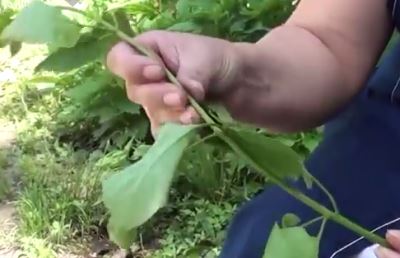 "Fatty" lilac escape
"Fatty" lilac escape - It is better to carry out the preparation early in the morning. Cut the cuttings from the shoot so that the cut is immediately below the lower pair of leaves (0.5-0.7 cm) and at an acute angle. Each cutting should have 2-3 leaf nodes, about 10-14 cm long.
- Then cut the bottom pair of leaves, and shorten all the upper leaf blades by 50%. Cut the top of the shoot above the top pair of leaves (0.8-1.1 cm) at a right angle.
 A good escape of lilac for the preparation of cuttings
A good escape of lilac for the preparation of cuttings Important! Do not cut more than 70-80% of annual shoots from the total. It is undesirable to cut the shoots every year from the same plant.
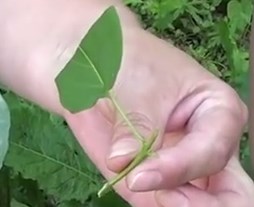 Sample harvested lilac cutting
Sample harvested lilac cutting Lilac cuttings in spring: instructions
- Properly prepared cuttings soak for a day in a solution with Epin Extra biostimulator - 1 ml per liter of water, for 10 cuttings, the working fluid is 200 ml. It is also possible for 15-18 hours in an aqueous solution with “Heteroauxin” (1 tablet (0.1 g) per liter of water) if there is no first stimulator.
After soaking, do not pour out the solution with Epin Extra, it is still useful for spraying the cutting after planting. - Prepare a landing site. It should be a penumbra, it can be a greenhouse, greenhouse or a separate part of the garden, if you cover with a plastic bottle (4-6 liters).
- Prepare the soil mix. Ideally, this composition: lowland peat, high-moor peat and coarse-grained perlite - 2: 1: 1, but low-moor peat, perlite - 2: 1.
Dig out the “cuttings” 35–40 cm in depth: there is 10–15 cm of drainage at the bottom of the pit (crushed stone, expanded clay), then 15–20 cm of rotted manure or compost and 5–8 cm of soil mixture from above. The second option: 10-15 cm drainage, 10-15 cm soil mixture and 3-4 cm on top of the sand. - Then spill the soil mixture with a fungicide solution (Fitosporin, potassium permanganate or iodine) to prevent fungal infections. For more information about the drugs in the article: "".
- Rinse the cuttings with clean water and dip into the Kornevin stimulator (powder). In the sand, make a small indentation with your finger or a pencil and plant a cutting in it so that the lower node plunges into it completely (1-1.5 cm), but does not touch the soil mixture.
Condense the sand near the cutting and spray them with water (it is good to add a soaking solution with Epin Extra to the water).
Planting distance: 10-12 cm between rows and 5-7 cm between cuttings, their leaves may touch each other slightly. - Cover the greenhouse (30-40 cm height, the closer to the cutting, the better) with a layer of film, then a translucent cloth or thin white paper to shade the cuttings on top and again a layer of film.
Or put a plastic mesh box or several thick branches (spruce branches) on top of the film. Or in the shade of a large shrub (jasmine, rhododendron). - To root the cuttings of lilac 2-3 times a day, air (3-4 minutes), and spray the cuttings. For better rooting, the humidity should not be less than 90%, and the temperature should be 23-26 ° C.
Once every 6-8 days, spray the cuttings with potassium permanganate (0.5 g for 2 liters of water - light pink) to prevent rot.
If the greenhouse has been shaded with a layer of paper or cloth, it is better to water the cuttings every 7-8 days, and there is no need for daily ventilation and spraying. - Rooting cuttings usually occurs in 40-70 days depending on the characteristics of the variety or type of lilac. Now they can begin to air for 2-3 hours a day in the evening. After another 20-30 days, the airing time is gradually increased and after 7-10 days the shelter is removed.
How to grow a lilac stalk after rooting?
Growing lilac cuttings has its own characteristics and rules, without which success is reduced many times.
- For the winter, cover the cuttings in October with an 8-10 cm layer of peat or dry leaves. In the fall, the leaves of the cuttings may darken, but the main thing is that the buds are alive.
- If the cuttings are well rooted, they can be transplanted to a separate bed (school) in early spring, but it is better to leave them in the “cuttings” until the fall (it is possible until next autumn so that they will settle down better).
The school should be located on a bright and quiet garden with a loose and fertile soil. You need to add compost (humus) to it, 1-2 glasses per 1m2 and dig 15-20 cm deep. Distance when planting rooted cuttings - 25-35 cm. - Transplanting should be done carefully, because the roots are very tender. It is not necessary to compact the ground during planting, it is enough abundant watering at the end.
- Water the saplings regularly, loosen the soil and feed them. More detail in the article about planting and caring for lilacs at the bottom of the page.
In October, seedlings cover with winter spruce or dry leaves, sawdust, peat. In late March - mid-April, the shelter must be removed. - The first 2-3 years of rooted cuttings grow weakly, as the roots actively develop, but then the growth is significantly accelerated. For the 3-4th year after cutting or 1-2 years of cultivation in the shkolka in late August - early September, lilacs can be transplanted to a permanent place. At the 4-5th year, the plant will delight flowering.
Note
Rooted on average 20-30% of lilac cuttings. The result is influenced by the correct cutting and care technique as well as the characteristics of the variety. Terry lilac rooted worse, especially without stimulants.
Lilac reproduction
Quite an easy way most breeds successfully propagate. ornamental shrubs (peony, rhododendron and others).
The advantage of reproduction by layering is fast planting material - 1 year, and the disadvantage is a small number of copies and the fact that it is better suited for native lilacs.
- In April - May, the last flight should be pressed to the ground in a small hole (8-12 cm), be sure to drag it with wire at the base and cover it with soil from above. Tie the top of the shoot to the peg.
- Regularly water the otvodku so that by the fall she was able to develop the roots well. With the growth of shoots, the edging spud 2-4 times over the summer.
- In early September, the layering can be cut, on one shoot can form 7-8 seedlings, and plant in a permanent place. Planting depth - root neck is 4-5 cm below ground level. If the roots are weak, then it is better to cut off the shoot to 20-25 cm.
Option for grafted lilac (vertical otvodka)
The maternal plant should be planted at an angle.
- In the spring above the grafting site (3-4 cm), drag the stem of the young shoots with copper wire and roll the bush 20-30 cm in height.
- Regularly water the bush. During the season, it may take 2-4 hilling, as the shoots grow, and the earth slides a little.
- By the end of August, the roots will appear above the waist and the layering can be cut off and planted in a permanent place.
Note
- Some experts believe that the cut is better to cut off in the spring, especially if small shoots. In this case, cover it for the winter with a 6-8 cm layer of peat or dry leaves, and in April, separate and plant it in a permanent place.
- With proper care lilac from cuttings bloom in the 3rd year.
Reproduction of lilac root shoots
The easiest way that you can propagate only own-rooted lilacs, since the vaccinated specimens are “wild” shoots from the rootstock and save the variety will not work.
To do this, in late August - early September, dig up shoots with a root and plant them in a permanent place in the garden.
Reproduction of lilac seeds
This method is only suitable for species specimens, because when propagated by seeds, the features of the variety are lost. Seeds propagate lilac mainly to produce rootstock for future vaccinations of cultivated varieties. And breeders for breeding new varieties.
- Before sowing, the seeds are stratified for two months (temperature 2-5 degrees Celsius), and then sown in spring (mid-March) into a sterilized soil mixture (peat, sand - 2: 1).
- Terms of germination differ in different species: common lilac - 13-16th day, Amur lilac - 65-85 days.
- As soon as a seedling forms 4 leaves, it is picked up - 3-4 cm from each other.
- In May, seedlings can already be planted in open ground, so that by the fall they adapt, develop better roots and successfully winter.
- After the first frost (October), cover the seedlings for the winter with 8-10 cm peat layer.
2nd option
- Seeds are harvested in late August - early September in order to have time to stratify them (45-60 days) before planting.
- In mid-October - early November, seed out at a depth of 1.5-2 cm and pour a 2-3 cm layer of compost on top.
- In spring, the seedlings dive, the entire season is watered regularly. In the winter they cover with mulch or spruce branches with dry leaves.
- In the 3rd year, seedlings can be used as a stock for vaccination (method - budding), their thickness is already about a pencil.
Note
Lilac grown from seeds, blooms on the 5-6th year.
ADDITION TO ARTICLE:
We wish you successful reproduction of lilac in any way and beautiful flowering!
Lilacs can be propagated by shoots (own-rooted specimens), layering, inoculation and green cuttings. Gardeners have the erroneous opinion that the own-rooted lilac blooms worse. However, it is not inferior to the grafted in size and beauty of inflorescences, moreover, it is more durable. There are landings that, with proper care, do not lose their decorative effect for more than 50 years.
One of the most affordable ways to breed lilac - green cutting . The best time for this is in the spring during flowering or immediately after it. Cuttings are cut from young green shoots, healthy and flexible. Such a stalk can be rolled into a ring, wrapping it around a finger, and it will not break. According to the location on the bush, it is better to take shoots from the middle and lower peripheral parts of the bush, crown shoots take root worse. Shoots from thick branches — tops or fat shoots — are not suitable for harvesting lilac cuttings; tops from lilac, as a rule, do not root. Shoots intended for cutting should not have flower buds, all the cuttings should give strength to growth and rooting, and not useless flowering attempts.
It is better to cut the shoots for grafting early in the morning, in wet or overcast weather. The cuttings should have two internodes, the lower section at an angle at some distance from the kidneys, and the upper straight line immediately above the buds. Use for this a well-sharpened grafting knife or a special pruner to injure the tissue as little as possible at the cut point. Cuttings cut precisely in the interstitial, not rooted. The lower pair of leaves is removed to avoid evaporation of moisture, the top - is shortened by half. The lower cut can be powdered with a root or soak for several hours in heteroauxin.
Root cuttings must be in the shade. A trench is torn up to a depth of twenty centimeters, a drainage is placed at the bottom - crushed stone, expanded clay or coarse sand, on top of a mixture of sand and peat. Not bad, if you replace part of the sand with perlite, it retains moisture better and at the same time breathes, preventing the rot from cuttings. Soil compacted and shed phytosporin solution, potassium permanganate or other fungicide. The stem of the cutting is about 2 cm deep, the lower node with the kidneys should be below the level of the soil. The distance between seedlings 4-5cm. Then the cuttings are spilled with water and covered with transparent cans or cut plastic bottles. If you plant a lot of cuttings, you can build a common overhang of transparent plastic film over them. In hot weather, especially if the rays of the sun fall on the landing site, it is advisable to additionally white paper, cloth or agrofibre. The optimum temperature for rooting is 22-26 degrees, the air humidity is 85 -95%, it is maintained by careful spraying of plants so that small droplets always cover the leaves.
![]()
Further rooting strongly depends on the lilac variety you choose: in some varieties the rooting rate of cuttings is up to 80-90 percent, in other varieties it is no more than ten to fifteen percent, so the more cuttings you prepare, the higher the chance for young seedlings to get. It would not be superfluous to use various growth stimulants, for example, Epin, Zircon, etc.
The process of rooting in lilac takes a long time, the first weak roots appear in 1-1.5 months. All this time, the plant must be carefully watered and from time to time to air the school. Fertilizing with biologics, such as Biovit, Riverm, and potassium humate is desirable. In the year of rooting, the plant does not shoot, but increases the root system. The leaves on the cuttings usually darken by the end of the season - it is not terrible, if the buds are alive, the plants must take root. In the fall, young bushes are covered with fallen leaves, spruce branches or agrofiber, and as such they will wait for the next spring. In the spring, the plants are transplanted to another school, with a large distance between them, but still they must be protected from direct sunlight.
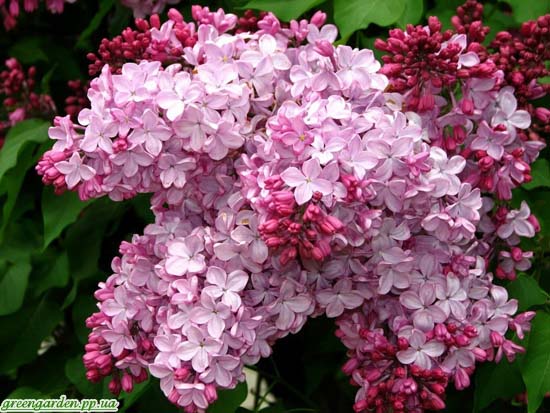
In autumn, the plants are moved to a permanent place, flowering usually begins on the fourth or fifth year after cuttings are cut.
All varieties of lilac breed well layering . Layers can be obtained by spuding vertically growing young shoots. To this end, the uterine bush is severely pruned in the fall, next year shoots grown by 15–20 cm are overtightened at the base with copper wire or a transverse incision is made under the first pair of developed buds. These techniques stimulate rooting. Then shoots spud at half their length, and as they grow, add fertile soil. In September, they are carefully excavated, cut with shears under the place of constriction and planted in shkolka, somewhat buried.
There is another, the so-called Chinese method of assigning shoots. A 3-4-year-old plant is selected as a uterine bush, which is cut in autumn “on a stump”, leaving two pairs of well-developed buds. Pristvolny circle fertilized with humus, hemp for the winter cover sheet. In spring, shoots develop from the buds, which are also cut in a similar fashion next fall. They do this until 8-10 shoots grow on the mother bush. In early spring, half of them are laid out into grooves 1.5-2 cm deep, pinned in several places with aluminum wire and sprinkled with fertile earth. Root formation is stimulated by over-pulling shoots with copper wire under the first pair of buds before or after bending down.
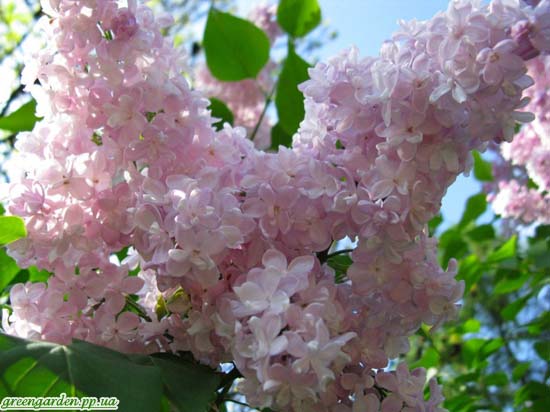
Rooting begins in 45-50 days. As new shoots grow from awakened buds, they are spud earth for better rooting. Throughout the growing season, lilacs are carefully looked after: they water regularly, loosen the soil, spud shoots 2-3 times. In the fall, the layers are carefully separated with shears, leaving a stump 10 cm long, and planted on the prepared ridge for growing.
Another way of breeding own-rooted lilac varieties - branch sprouts which can be held twice per season. In early June, when young shoots reach 5-7 cm in height, they are planted in a cold greenhouse, carefully separated along with delicate roots. Here, for two weeks, the seedlings are kept under film and sprayed with water. Then the shelter is removed and watered as needed. In the winter they are left in the greenhouse, and in the spring they are transplanted for rearing in a shkolka. The second time the shoots can be separated from the uterine bush in late August and early September. By this time, the shoots lignified and have a developed root system. They are transplanted to the ridge and covered with fallen leaves.
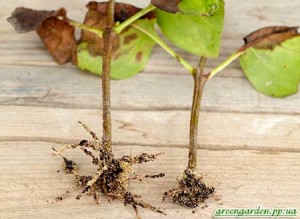
From spring to midsummer, own-rooted lilac varieties can be propagated grafting underground shoots . If possible, young, light-colored underground shoots and cut them with pruning shears on cuttings 10 cm long. For planting, prepare a bed with a film cover or a cold greenhouse. The cuttings are planted obliquely at a distance of 20 cm. The upper end should be underground at a depth of about 1 cm. With regular watering, green shoots appear after 20 days. Rooted cuttings for 2 years grow on the garden before planting on a permanent place.

